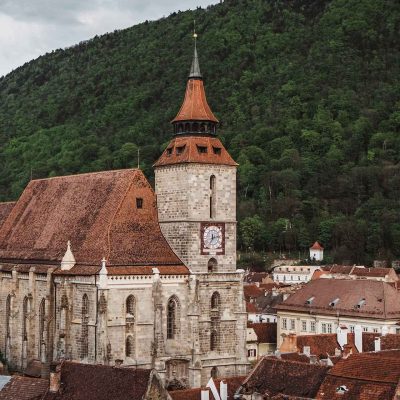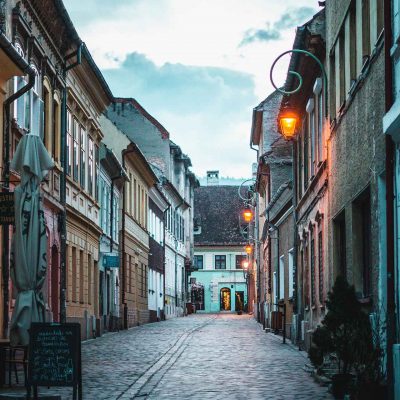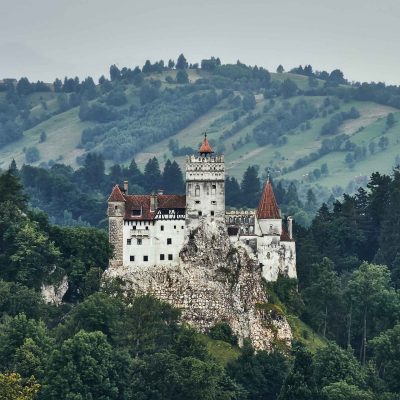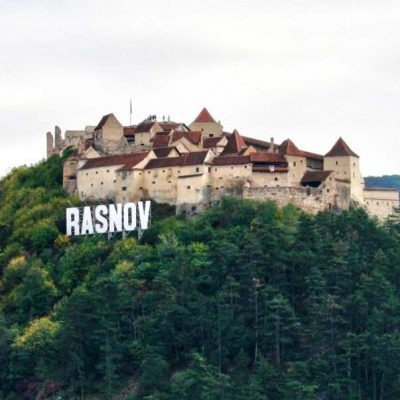Brașov’s unique air is given by the numerous buildings built in the Renaissance, Baroque and Gothic style. This city in Transylvania has a well-preserved historic city centre, where you can revel in the view while enjoying the traditional food served at the many restaurants found on the city’s cobbled streets.
During the summer season there are many cultural and leisure events to be enjoyed. Just 30 km away from Brașov you can find Bran Castle, the historic building which inspired Bram Stoker when he wrote his novel ‘Dracula’.
Brașov’s first official mention in 1235 was under the name of “Corona” and it was only in 1252 that it appeared under the name it holds today. The fourteenth century saw the period of economic and commercial rise of the city. In the 15th century, Brașov was under Ottoman rule only for it to be incorporated into the Habsburg Empire in 1686.
In 1689 a fire devastated the city. Later, the city develops and, during the revolution of 1848, Brașov became the most important bourgeois centre in Transylvania. After the end of the First World War, Brașov became part of Romania. During the communist period, the city was a prolific industrial centre and after the revolution of 1989, due to the actions taken against the regime, it received the title of “martyr city“.
Brașov is located in the centre of Romania and is a major part of the Brașov and Făgăraș depressions. The landscape units in the area have altitudes starting from 400m and going up to 2.544 m. The municipality is located at the foot of the Piatra Mare and Postavaru massifs.
Brașov is surrounded by three hills: Tâmpa, Straja and Dealul Cetății. The neighbouring regions are: to the north – Harghita, to the east – Covasna, to the south – Prahova, to the west – Sibiu.


Old Town – It is a charming architectural gem, with a rich history and a vibrant atmosphere. Its narrow, cobblestone-paved streets lead you into a realm of the past, where medieval buildings with colorful facades, imposing churches, and defense towers greet you at every turn. The Council Square, the heart of the old town, is dominated by the famous Black Church, a symbol of Brasov, alongside the Council House and the Clock Tower.
Here, cozy cafes and restaurants await you with hospitality, while fairs and cultural events always bring life and joy to this charming part of the city. A stroll along its picturesque streets invites you to discover the history and local traditions, thus complementing the unique experience offered by Brasov’s Old Town.


The Fortress – Located on Straja Hill (Citadel Hill), it is a historic landmark that watches over the city with grandeur and importance. The fortress served as a refuge for the residents of Brasov from the Habsburgs, then it served as a prison, and later, the Citadel became a storage space for the State Archives of Brasov.
Today, at the heart of the citadel, there is a restaurant where various events are often organized. Visitors can explore the ruins of the fortress walls and towers, experiencing a tangible connection to the medieval past of the city. The Citadel on Straja Hill stands as a testament to Brasov’s rich history and enduring resilience.


Weavers’ Bastion – Built by the weavers’ guild on four levels, the bastion occupies an area of 1,616 square meters and has a unique architecture in Southeast Europe. The building retains its original shape, with walls between 4 m at the base and 1 m at the fourth level of the building. It represents one of the bastions of the old fortress of Brașov, where today there is a permanent exhibition entitled “The Fortress of Brașov and the fortifications from Ţara Bârsei“. In recent years, the Bastion is used for parties and especially for opera concerts, due to its extraordinary acoustic qualities.


Bran Castle – It is undoubtedly one of the most sought-after tourist attractions in the area. The castle carries a rich historical, military, and economic significance, being associated with the name of Queen Marie of Romania, but it is known worldwide mainly due to the legend of Dracula from Bram Stoker’s novel.
Although initially the main function of the castle was as a defense fortress against Turkish invasions, and later transforming into a customs point on the trade route between Transylvania and Wallachia, in 1920 the residents of Brasov gifted the Castle to the Royal Family of Romania. The castle thus became the favorite residence of Queen Marie and later of her daughter, Princess Ileana. Presently, Bran Castle is owned by the descendant of Princess Ileana, Dominic de Habsburg, and serves as a museum.
The castle is located about 30 km from Brasov, but there are many access options: by car, bus, taxi, etc. And, if you’re visiting Bran Castle, along the way, you can stop at another beautiful place with a lot of history behind it: Rasnov Citadel.


It is one of the Transylvanian fortifications that has been exceptionally preserved, despite the passage of time. Built in the 14th century, this strong fortification was meant to withstand enemy siege. In the 17th century, the interior of the fortress was organised as a small settlement with houses, school, chapel and fountain, thus being able to ensure the quasi-normal life of the population in the long run.
In 1923, impressed by the advantages gained by the people of Bran after the transformation of Bran Castle into the private residence of Queen Maria, the City Council of Râşnov decided to give the fortress of Râşnov to Crown Prince Carol of Romania, hoping that the future King Carol II would turn it into a place of relaxation for him and his family, but Carol was not interested in living in a medieval fortress.


Brasov Airport is not yet operational and therefore, the closest options for flying are: Sibiu (141 km) and Târgu Mureș (170 km) airports.
If you want to opt for a train journey from Bucharest to Brașov, the fastest option would be with the Intercity. Every day, there are trains to and from Bucharest that connect Brașov to Arad, Cluj-Napoca, Oradea, Satu Mare, Sibiu, Sighișoara and several other cities in the country.
If you prefer a faster option, you can choose to travel by bus/ minibus. Here you will find all the necessary information for this: bus stations and stops, departure and arrival times, destinations.
If you come from Bucharest to Brașov by car, the optimal route to follow is: E60: Bucharest – Ploiesti – Sinaia – Predeal – Brasov.
If you like music festivals, in Brașov you will find one to your taste, regardless of the style of music you prefer. Here you have a list with some of them, but you should know that every weekend there are events for all tastes.
Cerbul de Our Festival – takes place in the Council Square during August-September. It is, in fact, a musical competition through where many talented people stand out.
Oktoberfest – is a beer festival, which has now become a tradition; it is designed after the German festival carrying the same name
Dracula Film Festival – this is actually a competition in which horror, Sci-Fi, supernatural, thriller and fantasy films are projected.
What are you waiting for?
Come and have a good time, enjoy music, nice people and magical places.